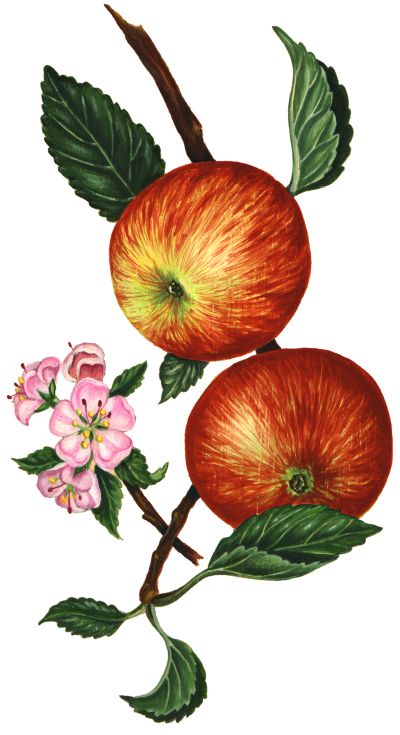Domestic Apple
Domestic Apple
Malus domestica Borkh.
Family Rosaceae — Rosaceae
Apple Description
The domestic apple is a deciduous tree, 3–12 m tall, with a spreading or pyramidal crown. Leaves are alternate, oval, 5–10 cm, with a serrated edge, dark green. Flowers are white or pink, 2–4 cm, gathered in umbrella-shaped inflorescences (4–8 flowers). Fruits are apples, 5–15 cm, green, yellow, red or multicolored, with juicy pulp. Common Varieties: 'Gala', 'Granny Smith', 'Fuji', 'Honeycrisp', 'Red Delicious', 'Golden Delicious'. Flowering in April–May, fruiting in August–October.
Habitat and Ecology of Apple
The homeland of the apple is Central Asia, presumably Kazakhstan. It grows in temperate zones of Europe, Asia, North America, Australia, up to 1500 m above sea level. Cultivated in Russia, China, USA, Poland. Prefers loamy or sandy loam soils (pH 6.0–7.0), sunny areas, watering 20–30 l/tree once every 10–14 days. Propagated by grafting, cuttings, seeds. Yield: 50–150 kg/tree. Care: pruning, potassium fertilization (15–20 g/m²), protection against codling moth, scab. Used in landscaping, for hedges, as a honey plant.
Apple Raw Materials
Raw materials: fruits (fructus Mali domesticae), leaves (folia Mali domesticae), bark (cortex Mali domesticae). Fruits are harvested in August–October, dried at 40–50 °C (yield 10–15 %). Leaves are collected in June–July, dried at 40 °C (yield 15–20 %). Bark is collected in spring, dried at 30–40 °C (yield 10–15 %). Quality: fruits — no mold, green or red; leaves — green; bark — brown; moisture ≤12 %. Store in airtight containers (fruits: 1 year; leaves: 1 year; bark: 2 years). Sweet smell (fruits), neutral (leaves, bark), sweet and sour taste (fruits).
Chemical Composition of Apple
Fruits: water (85 %), sugars (up to 12 %), organic acids (malic, citric, up to 1 %), pectins (up to 1.5 %), vitamin C (up to 20 mg%), A, E, flavonoids, polyphenols, minerals (K, Fe, Mg). Leaves: flavonoids, tannins (up to 3 %), vitamin C (up to 30 mg%). Bark: tannins (up to 5 %), flavonoids. Fruit calorie content: 45–55 kcal/100 g (fresh), 200–250 kcal/100 g (dried).
Action and Application of Apple
Apple has antioxidant, anti-inflammatory, laxative, diuretic, general tonic effects. It is used for constipation, anemia, hypertension, colds, vitamin deficiency, skin inflammations. Fruits improve digestion, support heart health, lower cholesterol. Leaves help with throat inflammation, dermatitis. Bark is used for fever, for wound healing. Fruit juice increases appetite, supports liver health.
Precautions for Apple Use
Consumption of >1 kg/day of fresh or >200 g/day of dried fruits can cause diarrhea, bloating. Store juice at 0–5 °C for no longer than 24 hours. Give children under 3 years old ≤100 g/day of fruits. Seeds contain amygdalin (possible toxicity with excessive consumption). Long-term use of bark infusions (>2 weeks) requires medical supervision. Wash fruits thoroughly due to pesticides.
Contraindications for Apple Use
Allergy to Rosaceae, gastritis with increased acidity, stomach ulcer in acute stage, diarrhea, diabetes (for dried fruits), pregnancy, lactation.
Apple Recipes
- Fruit infusion for constipation. Pour 200 ml of boiling water over 30 g of dried apples, let steep for 30 minutes, drink 50 ml twice a day, for 5 days.
- Bark decoction for fever. Boil 5 g of bark in 200 ml of water for 10 minutes, drink 50 ml twice a day, for 5 days.
- Compresses for dermatitis. Pour 100 ml of boiling water over 10 g of leaves, let steep for 20 minutes, apply for 15 minutes, twice a day, for 7 days.
- Juice for anemia. Drink 50 ml of fruit juice twice a day, for 7 days.
- Apple Cider Vinegar Tonic. Mix 1-2 tablespoons of apple cider vinegar with 8oz water and a teaspoon of honey. Drink daily for digestion and general wellness.
- Baked Apple with Oats. Core an apple, fill with a mixture of oats, cinnamon, honey, and a pat of butter. Bake until soft.
Apple Cosmetics
Apples are used for skin care.
- Rejuvenating mask. 20 g of apple pulp, 10 ml of honey, apply for 15 minutes, rinse, twice a week.
- Lotion for oily skin. 20 ml of apple juice, 10 ml of water, wipe the skin, once a day.
- Moisturizing mask. 20 g of pulp, 10 ml of yogurt, apply for 20 minutes, rinse, twice a week.
- Leaf infusion for acne. Pour 100 ml of boiling water over 10 g of leaves, let steep for 20 minutes, wipe the skin, twice a day.
- Apple and Oatmeal Exfoliant. Mix finely grated apple with ground oatmeal and a little water to form a paste. Gently massage onto the face, then rinse.
- Apple Hair Rinse. Dilute apple cider vinegar with water (1:2 ratio) and use as a final rinse after shampooing for shine and to balance scalp pH.
Apple Culinary Uses
Fruits are used fresh, dried, in desserts, beverages.
- Compote. 200 g of fresh apples, 1 l of water, 50 g of sugar, boil for 15 minutes.
- Jam. 1 kg of apples, 800 g of sugar, 200 ml of water, cook for 30 minutes, store in jars.
- Puree. Cook 500 g of apples for 20 minutes, mash, add 50 g of sugar.
- Smoothie. 200 g of apples, 100 ml of yogurt, 10 g of honey, blend.
- Apple Pie. Classic dessert with sliced apples, cinnamon, and sugar baked in a pastry crust.
- Apple Crisp/Crumble. Sliced apples baked with a crunchy topping of oats, flour, butter, and brown sugar.
- Apple Sauce. Cooked and pureed apples, often with cinnamon, served as a side dish or dessert.
- Caramel Apples. Whole apples dipped in hot caramel and sometimes coated with nuts or sprinkles.
Tips: Store fresh fruits at 0–5 °C for up to 3 months, dried — for up to 1 year. Remove seeds before cooking.
Other properties of apple
Used in ornamental landscaping, for hedges, as a honey plant.




